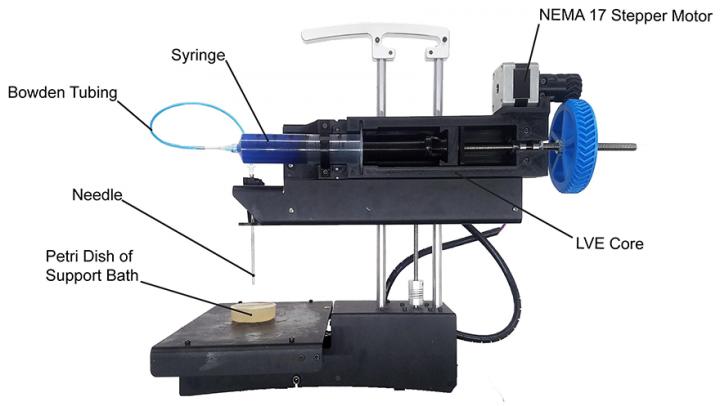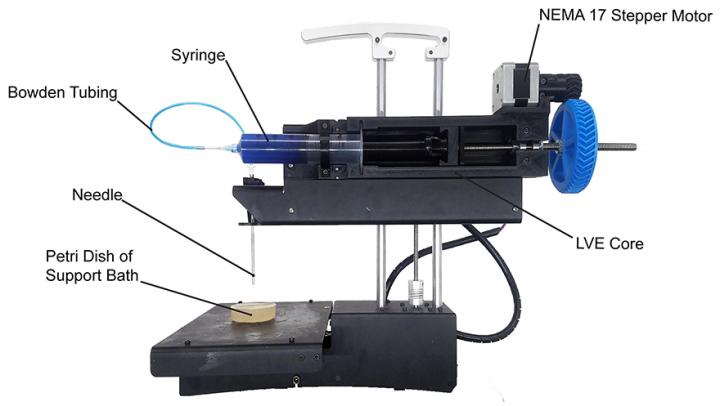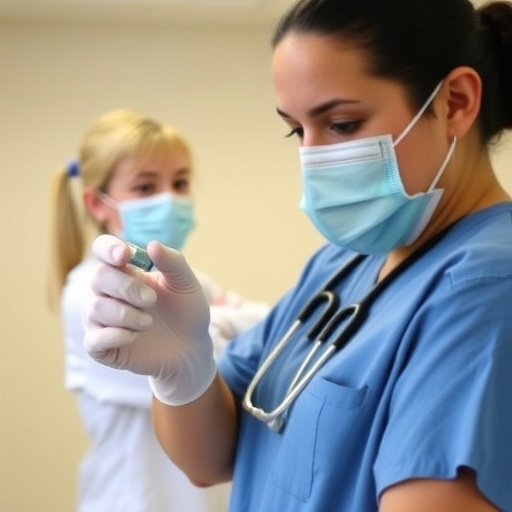
Credit: Adam Feinberg/HardwareX
Researchers at Carnegie Mellon University have developed a low-cost 3-D bioprinter by modifying a standard desktop 3-D printer, and they have released the breakthrough designs as open source so that anyone can build their own system. The researchers–Materials Science and Engineering (MSE) and Biomedical Engineering (BME) Associate Professor Adam Feinberg, BME postdoctoral fellow TJ Hinton, and Kira Pusch, a recent graduate of the MSE undergraduate program–recently published a paper in the journal HardwareX that contains complete instructions for printing and installing the syringe-based, large volume extruder (LVE) to modify any typical, commercial plastic printer.
"What we've created," says Pusch, "is a large volume syringe pump extruder that works with almost any open source fused deposition modeling (FDM) printer. This means that it's an inexpensive and relatively easy adaptation for people who use 3-D printers."
As the researchers explain in their paper, "Large volume syringe pump extruder for desktop 3D printers," most commercial 3-D bioprinters currently on the market range in cost from $10,000 to more than $200,000 and are typically proprietary machines, closed source, and difficult to modify.
"Essentially, we've developed a bioprinter that you can build for under $500, that I would argue is at least on par with many that cost far more money," says Feinberg, who is also a member of the Bioengineered Organs Initiative at Carnegie Mellon. "Most 3-D bioprinters start between $10K and $20K. This is significantly cheaper, and we provide very detailed instructional videos. It's really about democratizing technology and trying to get it into more people's hands."
And not only does the LVE cut down on cost, it also allows users to print artificial human tissue on a larger scale and at higher resolution, opening doors for researchers, makers, and professionals to experiment with 3-D printing biomaterials and fluids.
"Usually there's a trade-off," explains Feinberg, "because when the systems dispense smaller amounts of material, we have more control and can print small items with high resolution, but as systems get bigger, various challenges arise. The LVE 3-D bioprinter allows us to print much larger tissue scaffolds, at the scale of an entire human heart, with high quality."
"Bioprinting has historically been limited in volume," adds Pusch, "so essentially the goal is to just scale up the process without sacrificing detail and quality of the print."
Pusch, the first author on the paper, was a research assistant in Feinberg's lab for three years during her undergraduate career. During that time, she received an International Summer Undergraduate Research Fellowship (iSURF) to work in the Netherlands, and also interned with General Electric's Center for Additive Technology Advancement. Following her graduation from Carnegie Mellon in December of 2017, she began a spring internship at Formlabs in Boston and has since accepted a second internship position for the summer at Blue Origin in Seattle. Pusch has also co-authored a second paper in ACS Biomaterials Science & Engineering with Hinton, "3D Printing PDMS Elastomer in a Hydrophilic Support Bath via Freeform Reversible Embedding." As a research assistant in Feinberg's lab, Pusch was able to experience real-world application of her research early on in her academic career. When asked about her experience in Feinberg's lab, Pusch emphasizes how grateful she is to have had the opportunity to work with such supportive and brilliant mentors.
In their paper, the researchers demonstrated the system using alginate, a common biomaterial for 3-D printing, and using the lab's signature Freeform Reversible Embedding of Suspended Hydrogels (FRESH) technique.
Feinberg's lab aims to produce open source biomedical research that other researchers can expand upon. By making their research widely accessible, Feinberg's lab hopes to seed innovation widely, to encourage the rapid development of biomedical technologies to save lives.
"We envision this as being the first of many technologies that we push into the open source environment to drive the field forward," says Feinberg. "It's something we really believe in."
###
Media Contact
Emily Durham
[email protected]
412-268-2406
@CMUEngineering
http://engineering.cmu.edu
Original Source
https://engineering.cmu.edu/news-events/news/2018/03/23-bioprinter-feinberg.html http://dx.doi.org/10.1016/j.ohx.2018.02.001





